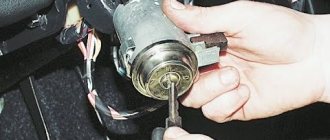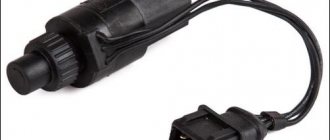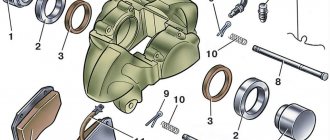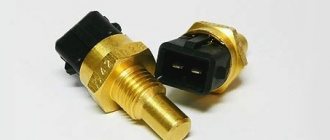Any internal combustion engine must be cooled in a timely manner. Without this, its normal operation is simply impossible. This rule is also true for VAZ 2107 engines. The most problematic device in the cooling system of this car is the sensor that records the temperature of the antifreeze in the main radiator. It often breaks down. Fortunately, you can replace it yourself. Let's figure out how best to do this.
- Antifreeze temperature sensor device
Electromechanical temperature sensor - Electronic temperature sensor
- Location of the antifreeze temperature sensor on the VAZ 2107
- Test sequence
- Sequence of operations
Purpose of the temperature sensor VAZ 2107
The sensor monitors the temperature of antifreeze in the main cooling radiator of the VAZ 2107 and transmits the signal to the dashboard. In its lower left corner there is a dial indicator for the antifreeze temperature.
Sensor showing coolant temperature VAZ 2107
If the temperature rises above 95 degrees, this means only one thing: the cooling system is not doing its job and the engine is close to overheating.
The temperature sensor of the VAZ 2107 transmits a signal to the dashboard
Instrument location
The coolant temperature sensor (CTS) is embedded in the cooling radiator. It is this position, in which there is direct contact with the heating antifreeze, that ensures high sensitivity of the part.
In outdated models, the meter acted as a plug to close the tank. In the new ones, the drain passage is sealed with a separate plug, and the temperature sensor has its own hole.
The device is located directly on the engine block head. To find it, you should look at the power unit on the left, or follow the outgoing wire from the instrument panel to which the meter is connected. After the car owner has found the device, further operations can begin.
Antifreeze temperature sensor device
Over the years, different types of temperature sensors were installed on VAZ 2107 cars. The earliest VAZ 2107 models had electromechanical sensors. Later they were replaced by electronic sensors. Let's take a closer look at the design of these devices.
Electromechanical temperature sensor
Electromechanical sensors have a massive steel body with thick walls, ensuring more uniform heating of the device. The body contains a chamber with ceresite. This substance is mixed with copper powder, and it reacts well to changes in temperature. The ceresite chamber of the sensor is closed by a very sensitive membrane connected to the pusher. When hot antifreeze heats the sensor body, the ceresite in the chamber expands and begins to put pressure on the membrane. The membrane moves up a pusher, which closes the system of moving contacts. The signal thus obtained is transmitted to the dashboard, informing the driver that the engine is overheating.
The device of the electromechanical temperature sensor VAZ 2107
Electronic temperature sensor
Electronic temperature sensors are installed only on new VAZ 2107. Instead of a membrane and a chamber with ceresite, the electronic sensor has a sensitive thermistor. As the temperature increases, the resistance of this device changes. These changes are recorded by a special circuit, which transmits a signal to the dashboard.
Electronic sensor device VAZ 2107
Location of the antifreeze temperature sensor on the VAZ 2107
The temperature sensor is screwed into the main cooling radiator of the VAZ 2107. This arrangement is quite natural: this is the only way the sensor can come into direct contact with boiling antifreeze. One nuance should be noted here: on early VAZ 2107 models, the temperature sensor also served as a plug closing the hole for draining antifreeze. In new VAZ 2107 cars, the drain hole is closed with a special plug, and the temperature sensor is screwed into its own, separate socket.
In old VAZ 2107 models, the temperature sensor also served as a plug
Temperature sensor malfunctions
There are two reasons why the sensor may not transmit a signal to the dashboard. Here they are:
- The fuse responsible for the temperature sensor has blown (the sensor itself may be working properly). To understand that the problem is in the fuse, the driver will have to look under the steering column, into the fuse block of the car. A burnt fuse will be immediately visible: it usually melts slightly and turns black;
Sometimes the sensor does not work due to a blown VAZ 2107 fuse - The temperature sensor itself has burned out. As a rule, this occurs due to a sharp voltage drop in the vehicle's on-board electrical network. The cause of such a jump may be a short circuit in the electrical wiring. The fact is that the insulation of wires on the VAZ 2107 has never been of high quality. Over time, it becomes unusable and begins to crack, which ultimately leads to a short circuit.
Why does the sensor fail?
There may be several reasons for the breakdown:
- Sensor insulation failure. If the wiring is poorly insulated, a short circuit occurs, which causes the device to burn out.
- The wires break near the sensor, which prevents the fan from turning on and the car overheats.
- The electrical contact located inside breaks or becomes cracked. In this case, accurate data transfer to the control panel is not possible.
Failure occurs more often in winter.
Checking the temperature sensor of the VAZ 2107
To carry out the test we will need the following tools:
- household multimeter;
- container with water;
- household boiler;
- thermometer;
- temperature sensor removed from the car.
Test sequence
- The sensor is lowered into the prepared container so that its threaded part is completely under water.
- A thermometer and a boiler are lowered into the same container (you need to make sure that these tools do not come into contact with each other).
- The multimeter contacts are connected to the sensor contacts, and the multimeter itself is configured to measure resistance.
- The boiler is plugged in and the water starts heating.
- When the water reaches a temperature of 95 degrees, the sensor resistance shown by the multimeter should disappear. If this happens, the sensor is working. If at the above temperature the resistance on the multimeter does not disappear, the sensor is faulty and needs to be replaced.
Video: checking the antifreeze sensor
Checking the electric fan and its circuits
In order to check the operation of the fan and power circuits on the injection “seven”, you need to disconnect the connector from the sensor, the ECU will give a command to turn on the fan. If this does not happen, then you need to check not the sensor itself, but the serviceability of fuse F7, the electric motor, the fan relay and the power circuits. Below is a diagram of how to turn on the VAZ 2107 injector cooling fan.
Circuit diagram for switching on the VAZ 2107 cooling fan (injector)
The principle of operation of such a device differs from TM 108 and is based on a change in resistance.
As the sensor heats up, it reduces the resistance; the ECU monitors this change and, when the specified parameter is reached (about 195 Ohms), turns on the fan relay.
On the carburetor model, everything is made somewhat simpler; if the fuse and relay are working properly, then in order for the electric motor to start, it is enough to remove the chips from the sensor and close them together.
The operating principle of the fan switch sensor installed on the radiator is this: in a cold state, the bimetallic plate opens the contacts, and when the temperature reaches 92 degrees (ideally), it closes and the relay is activated. In practice, quite often you can buy sensors with some spread in values. You can check the new one by heating it in water, controlling the temperature and switching on.
Replacing the antifreeze sensor on a VAZ 2107
First of all, it should be said that the temperature sensors on the VAZ 2107 cannot be repaired. The reason is simple: this device does not contain parts and materials that the driver could purchase and replace himself. In addition, the body of the temperature sensor is not dismountable, so it is simply impossible to get to the insides of this device without breaking it. Here's what you need to replace it:
- new temperature sensor VAZ 2107;
- 30mm socket with a long wrench (or a regular spark plug wrench);
- container for draining coolant.
Sequence of operations
- The car is placed on a viewing hole or on an overpass. Place a container under the drain hole, unscrew the plug, and drain the antifreeze.
A small basin is ideal for draining antifreeze from a VAZ 2107 - The contact wires are removed from the sensor. They must be carefully pulled towards you.
The red arrow shows the contact cap of the VAZ 2107 sensor - The sensor is unscrewed with a socket by 30 (remember that under the sensor there is a very thin o-ring that can be easily lost).
- A new one is screwed in place of the unscrewed sensor (and when screwing in a new sensor, you should not use too much force, especially if the driver of the socket head is very long: the thread in the sensor socket is easily torn off).
- The cap with the contact wires is put back on the sensor, and new antifreeze is poured into the expansion tank.
Video: replacing the coolant sensor on a VAZ 2107
Do-it-yourself replacement of the fan switch sensor
To replace the temperature sensor responsible for turning on the radiator fan on a VAZ 2107, it is recommended to follow the instructions given below.
- Remove the terminal from the battery.
- Drain the coolant from the radiator.
- Remove the terminals.
- Using a 30mm key, unscrew the meter.
- Check the condition of the copper O-ring and screw in the new sensor.
- Reassemble everything in reverse order.
Important nuances
There are several important points that cannot be left out. Here they are:
- The above sequence of replacing the sensor with completely draining the antifreeze is not always used. Experienced car enthusiasts do it simpler: they unscrew the faulty sensor, then clamp the drain hole with their finger. This action requires a fair amount of skill. But even if you do everything very quickly, some of the antifreeze will inevitably spill out and you will still have to top it up;
Sometimes car enthusiasts do not drain the antifreeze from the VAZ 2107 when replacing the sensor - When going to the store to buy a new temperature sensor, you should remember: you can now find both electromechanical and electronic temperature sensors on sale. It is better to choose electronic ones, despite the fact that they are more expensive than electromechanical ones (a good electronic sensor costs 500 rubles, and an electromechanical one - 300). The logic of choice is simple: the fewer moving parts there are in the sensor, the longer it will last.
So, replacing a temperature sensor is not a very difficult task. Even a novice car enthusiast can handle it if he has held a wrench in his hands at least once in his life. By precisely following the steps outlined in this instruction, the car owner can save about 700 rubles. This is how much it costs to replace a temperature sensor at a car service center.
Where is the switching temperature located?
The fan switching sensor is located on injection models, on the aluminum outlet pipe of the cylinder head (article - 23.3828, used in VAZ-2107i-2112, 21213, 2123, ALFA ROMEO, DAEWOO, FIAT, LANCIA, OPEL), on carburetor models (TM 108 -02 92/87 C) it is installed on the engine cooling radiator.
For the “classic” fan, the operating temperature is 92 degrees and the shutdown temperature is 87 C 0, so installing a fan that is suitable in size, but with a different number, is not recommended.
On carburetor models the sensor is located on the radiator











